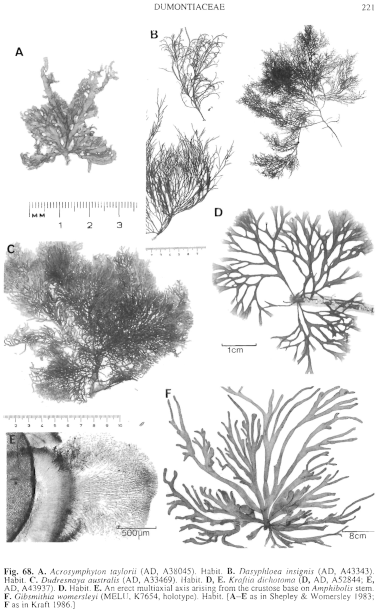|
|
|
|
|
|||||||||||
|
Electronic Flora of South Australia Species Fact Sheet
Phylum Rhodophyta – Class Florideophyceae – Order Gigartinales – Family Dumontiaceae
Selected citations: Millar & Kraft 1984:135, figs 2–10. Shepley & Womersley 1983: 202, figs 1A, B, 3.
Thallus (Fig. 68A) medium red, 4–21 cm high, with an axis 2–5 mm broad producing laterals 2–8 mm in diameter bearing slender tapering branches for 3 or 4 orders, soft and mucilaginous. Holdfast small, discoid; epilithic. Structure uniaxial with each axial cell bearing 4 periaxial cells (and sometimes adventitious filaments) which produce lateral filaments (Fig. 69A) with several orders of cells, the outer forming a lax cortex and with many inner medullary cells producing descending rhizoids.
Reproduction: Sexual thalli dioecious or monoecious. Carpogonial branches (Fig. 69B) developing from periaxial cells or from second or third order cells of the lateral filaments, replacing one of the vegetative filaments on their bearing cell, 9–10 cells long with the carpogonium sharply reflexed towards cells 4 and 5 (Fig. 69B, C) and a long and usually basally coiled trichogyne. One to four cells nearest the base of the carpogonial branch produce no laterals but the next 5–6 cells form distichous lateral branches 2–4 cells long (Fig. 69B), which may further cut off 1–2-celled side branches towards the recurved carpogonium; the cell below the carpogonium does not cut off lateral cells. Post-fertilization fusion occurs between the carpogonium and terminal cells of these lateral branches, usually those from cells 4 and 5 of the carpogonial branch, while the cell below the carpogonium remains densely cytoplasmic. Following this fusion, several connecting filaments with basal pit-connections develop (Fig. 69C). Auxiliary cell branches (Fig. 69B) develop in similar positions to the carpogonial branches, and are 5–9 cells long without lateral cells and with a larger, subspherical, terminal auxiliary cell, with which a connecting filament fuses and initiates gonimoblast cells (Fig. 69D); each connecting filament usually continues to further auxiliary cells. Carposporophytes (Fig. 69D) globular, scattered in the outer medulla, 80–100 µm in diameter, with nearly all cells becoming sub-spherical carposporangia 12–20 µm in diameter. Male gametophytes (Hawaiian plants) smaller than female gametophytes, with small clusters of spermatangia on outer cortical cells.
Tetrasporophytes unknown.
Type from Hauula, Oahu, Hawaiian Islands; holotype (Abbott 1461) in BISH. Isotypes in UC (912181) and BISH.
Distribution: Oahu, Hawaiian Islands.
In Australia known from isolated records from Rottnest I., W. Aust., Coffs Harbour, N.S.W. (Millar & Kraft 1993, p. 15), Queensland and Lord Howe I. (Millar & Kraft 1984, p. 135).
Taxonomic notes: Southern Australian record: Egg I., Isles of St Francis, S. Aust., 32–38 m deep (Shepherd, 11.i.1971; AD, A38045).
A. taylorii is essentially a tropical species, with the above single specimen known from southern Australia.
References:
ABBOTT, I.A. (1962b). Morphological studies in a new species of Acrosymphyton (Rhodophyceae). Amer. J. Bot. 49, 845–849.
MILLAR, A.J.K. & KRAFT, G.T. (1984). The red algal genus Acrosymphyton (Dumontiaceae, Cryptonemiales) in Australia. Phycologia 23, 135–145.
MILLAR, A.J.K. & KRAFT, G.T. (1993). Catalogue of Marine and Freshwater Red Algae (Rhodophyta) of New South Wales, including Lord Howe Island, South-western Pacific. Aust. Syst. Bot. 6, 1–90.
SHEPLEY, E.A. & WOMERSLEY, H.B.S. (1983). The Dumontiaceae (Cryptonemiales: Rhodophyta) of southern Australia. Trans. R. Soc. S. Aust. 107, 201–217.
The Marine Benthic Flora of Southern Australia Part IIIA complete list of references.
Publication:
Womersley, H.B.S. (14 January, 1994)
The Marine Benthic Flora of Southern Australia
Rhodophyta. Part IIIA, Bangiophyceae and Florideophyceae (to Gigartinales)
Reproduced with permission from The Marine Benthic Flora of Southern Australia Part IIIA 1994, by H.B.S. Womersley. Australian Biological Resources Study, Canberra. Copyright Commonwealth of Australia.
Illustrations in Womersley Part IIIA, 1994: FIGS 68A, 69 A–D.

Figure 68 enlarge
Fig. 68. A. Acrosymphyton taylorii (AD, A38045). Habit. B. Dasyphloea insignis (AD, A43343). Habit. C. Dudresnaya australis (AD, A33469). Habit. D, E. Kraftia dichotoma (D, AD, A52844; E, AD, A43937). D. Habit. E. An erect multiaxial axis arising from the crustose base on Amphibolis stem. F. Gibsmithia womersleyi (MELU, K7654, holotype). Habit. [A–E as in Shepley & Womersley 1983; F as in Kraft 1986.]

Figure 69 enlarge
Fig. 69. A–D. Acrosymphyton taylorii (AD, A38045). A. Cortical branch system with a young auxiliary cell branch. B. Mature carpogonial branch and adjacent auxiliary cell branch. C. A carpogonial branch with a terminal lateral cell acting as an auxiliary cell with a connecting filament and 2-celled gonimoblast. D. A young carposporophyte surmounting an auxiliary cell branch. E–J. Dudresnaya australis (E–H, J, AD, A30830; I, AD, A33861). E. Mature carpogonial branch with spermatia on trichogyne. F. Post-fertilization carpogonial branch producing connecting filaments. G. Auxiliary cell with connecting filaments and first gonimoblast cell. H. Mature carposporophyte on auxiliary cell filament. I. Spermatangial branch in sectional view. J. Tetrasporangia on cortical filaments. [A–J after Shepley & Womersley 1983.]

|
Email Contact: State Herbarium of South Australia |

|